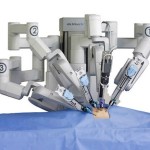 The last few years have seen a number of fascinating innovations in the surgical world. Google Glass was one of the earliest applications, before this naturally moved onto augmented reality and the 3D manufacture of models for surgeons to practice on.
The last few years have seen a number of fascinating innovations in the surgical world. Google Glass was one of the earliest applications, before this naturally moved onto augmented reality and the 3D manufacture of models for surgeons to practice on.
What is abundantly clear is that automation is playing an increasingly valuable role in the operating room. Initial results suggest that automation both reduces hospital stays whilst also making the process safer and more effective.
Tactile automation
Something robotic innovations have thus far struggled with however is the more tactile elements of the surgeons work. A recent study by academics at the John A. Paulson School of Engineering and Applied Science and the Wyss Institute for Biologically Inspired Engineering suggests that may be about to change.
A major challenge in achieving this is that fitting the kind of sensors required for the creation of tactile robotics can often make the robots too large for the delicate work of surgery.
“Current conventional fabrication techniques limit the complexity and the sophistication of these millimeter-sized sensors while significantly driving up the cost of assembly and implementation,” the authors say. “This poses a barrier to widespread adoption of force-sensing soft robotic surgical tools that can perform minimally invasive and complex surgeries in an inherently safe way.”
Pop-up manufacturing
To get around this problem, the team utilized pop-up manufacturing. As the name suggests, this approach was inspired by pop-up books and layers laser-cut materials into thin, flat plates that pop-up into complete devices.
By allowing the robots to essentially build themselves, it promises to make the manufacturing process considerably cheaper. They are capable of building devices just 2.7mm in size, which is easily small enough to fit inside a 8.6mm endoscope.
The sensors themselves utilize light intensity modulation (LIM) to enable the devices to sense force at a millinewton level.
The next step for the project is to try and make the sensor both smaller and more robust to eventually provide the surgical robots with a sense of touch.
“This manufacturing technology could be a disruptor in the surgical robotics field,” the authors say. “It will enable new possibilities for sensors and end-effectors that can be placed at the tip of flexible surgical tools.”
“The ability to rapidly and inexpensively create millimeter-scale surgical tools with embedded sensors and actuators will find numerous applications in laparoscopy and endoscopy,” they conclude.
Poke poke I like imagining surgeons just being like is this squishy and then grinning like little kids and pulling this thing out
The rise in healthcare expenditure, growing elderly population, technological advancement, increasing incidence of chronic diseases, rise in consumer spending in healthcare, high incidence of medication errors and growing demand for robot assisted surgical systems are sure to drive a big increase in demand for this kind of thing. Very impressive advances.